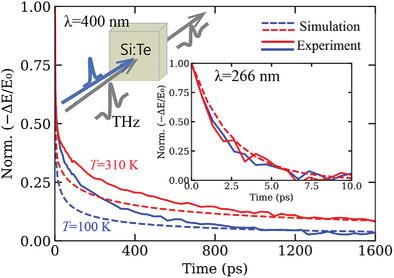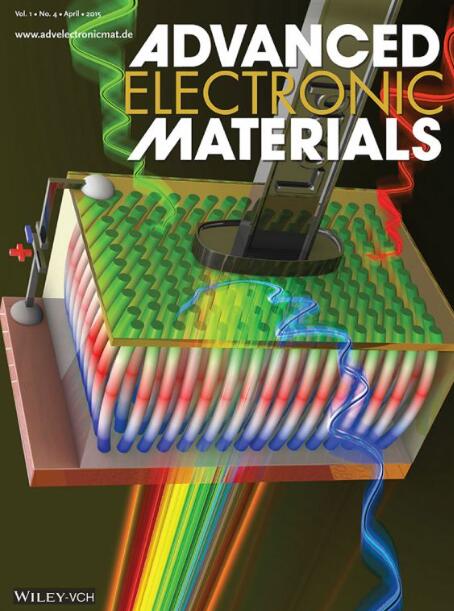超掺碲硅中电荷载流子的温度相关动力学
IF 5.3
2区 材料科学
Q2 MATERIALS SCIENCE, MULTIDISCIPLINARY
引用次数: 0
摘要
碲超掺杂硅(Si:Te)有望成为高效太阳能电池和光电探测器的中间带候选材料。我们利用时间分辨太赫兹光谱(TRTS)来研究超掺杂 0.5%、1% 和 2% 的硅的激发载流子动力学。两种光激发波长使我们能够了解超掺杂区与硅区相比随温度变化的载流子传输。在波长为 400 纳米的光激发下,温度对瞬态电导率的大小和衰减时间有很大影响。由于硅区和超掺杂区的迁移率不同,因此在 266 纳米激发下不存在这种依赖性。与文献报道一致,电荷载流子寿命随着掺杂浓度的增加而降低。研究发现,随着掺杂剂浓度的增加,光导率对温度的依赖性减小。模拟结果表明,载流子扩散受浓度梯度的驱动,与温度密切相关,并影响瞬态光电导衰减曲线。模拟还显示,在超掺杂区域,载流子重组率与温度无关。本文章由计算机程序翻译,如有差异,请以英文原文为准。

Temperature-Dependent Dynamics of Charge Carriers in Tellurium Hyperdoped Silicon
Tellurium-hyperdoped silicon (Si:Te) shows significant promise as an intermediate band material candidate for highly efficient solar cells and photodetectors. Time-resolved THz spectroscopy (TRTS) is used to study the excited carrier dynamics of Si hyperdoped with 0.5, 1, and 2%. The two photoexcitation wavelengths enable us to understand the temperature-dependent carrier transport in the hyperdoped region in comparison with the Si region. Temperature significantly influences the magnitude of transient conductivity and decay time when photoexcited by light with a wavelength of 400 nm. Due to the differential mobilities in the Si and hyperdoped regions, such dependence is absent under 266-nm excitation. Consistent with the literature, the charge-carrier lifetime decreases with increasing dopant concentration. It is found that the photoconductivity becomes less temperature-dependent as the dopant concentration increases. In the literature, the photodetection range of Si:Te extends to a wavelength of 5.0 µm at a temperature of 20 K. The simulation shows that carrier diffusion, driven by concentration gradients, is strongly temperature dependent and impacts transient photoconductivity decay curves. The simulation also revealed that, in the hyperdoped regions, the carrier recombination rate remains independent of temperature.
求助全文
通过发布文献求助,成功后即可免费获取论文全文。
去求助
来源期刊

Advanced Electronic Materials
NANOSCIENCE & NANOTECHNOLOGYMATERIALS SCIE-MATERIALS SCIENCE, MULTIDISCIPLINARY
CiteScore
11.00
自引率
3.20%
发文量
433
期刊介绍:
Advanced Electronic Materials is an interdisciplinary forum for peer-reviewed, high-quality, high-impact research in the fields of materials science, physics, and engineering of electronic and magnetic materials. It includes research on physics and physical properties of electronic and magnetic materials, spintronics, electronics, device physics and engineering, micro- and nano-electromechanical systems, and organic electronics, in addition to fundamental research.
 求助内容:
求助内容: 应助结果提醒方式:
应助结果提醒方式:


